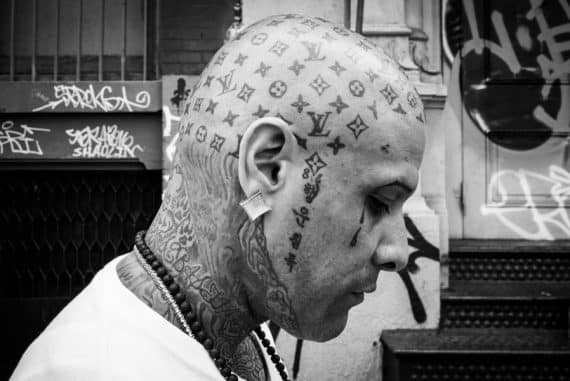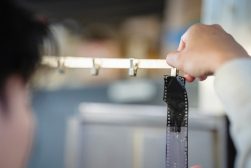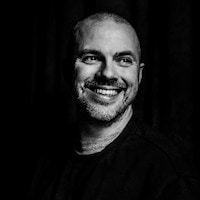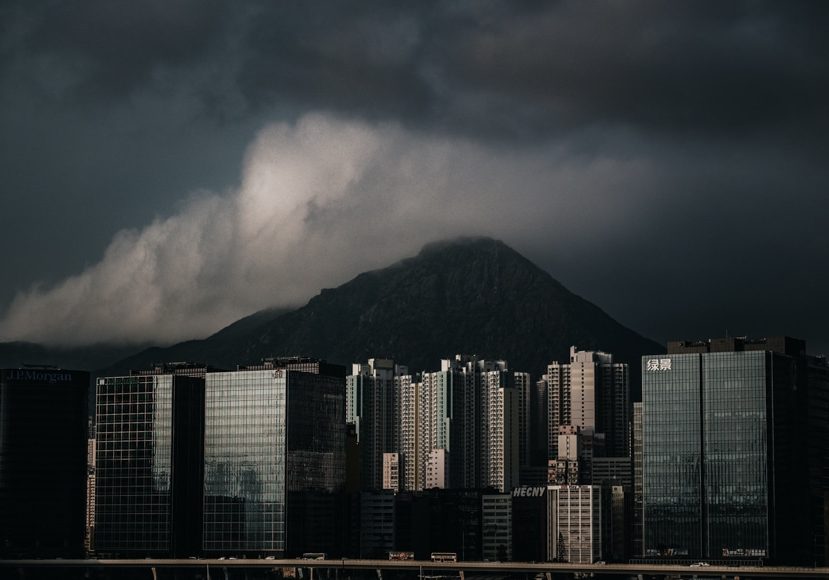
Guide to City & Urban photography
Find out the best City & Urban Photography tips in this must-read guide! Learn how to get started or take your city and street shots to the next level.
Learn | By Patrick Mateer
Urban photography is about cities and capturing the experience of being in them.
It may be about the buildings, the roadways and the urban spaces; it may show people at work, moving around, shopping or enjoying a leisure activity. It can be in any country in the world.
It covers a vast range of subjects and stimulates many different approaches to photographing them.
There’s lots to look at, so let’s get started.
What is Urban Environment Photography?
In this section, we will answer the question: ‘what does ‘urban’ mean in photography’? To do that, we need to look at the wider context and at some of the sub-genres associated with it.
A quick list of key phrases associated with urban photography gives an idea of the richness of subject matter:
- downtown and suburban sprawl
- the hustle of markets and streets
- people at work and at play
- daytime and night-time; artificial light and shafts of sunlight
- signage, advertising and hoardings
- rich and poor
- ancient, traditional, and modern
- traffic: cars, taxis, bicycles, rail, roads, subways, bridges and roadworks
- construction, demolition, and urban decay
When we consider the genres urban photography covers, we begin to see what a varied type of photography this is. These include ‘street photography’, ‘urban environment’ and ‘urban decay’ photography.
‘Street photography’ is the exploration through photographs of human life within built-up city areas. It usually includes people – or at least the traces of people, like a lost glove stuck on some railings.
From the vastness of wide-angle shots – ‘cityscapes’ – to the telling detail of a plant growing from the mortar exposed in slowly disintegrating old posters. From a single person in a city street to a huge crowd.
The name ‘street photographer’ is generally applied to photographers who go out into the streets with handheld cameras taking documentary or candid shots of people going about their ordinary life – though as the best street photographers show, many lives are not so ‘ordinary’.
If you want to learn more, look at the work of the greats of street photography: Walker Evans, Robert Frank, Joel Meyerowitz, Eugène Atget, Dorethea Lange, Vivian Maier, Martin Parr, Brassai, Cartier-Bresson, Garry Winogrand, William Eggleston, Helen Levitt and Lee Miller, to name a few.
While photographers have always taken photos in the street, it was the coming of smaller cameras and fast lenses – such as those made by Leica – that stimulated the working practice of photographers such as André Kertész, Cartier-Bresson and Walker Evans in the 1930s.
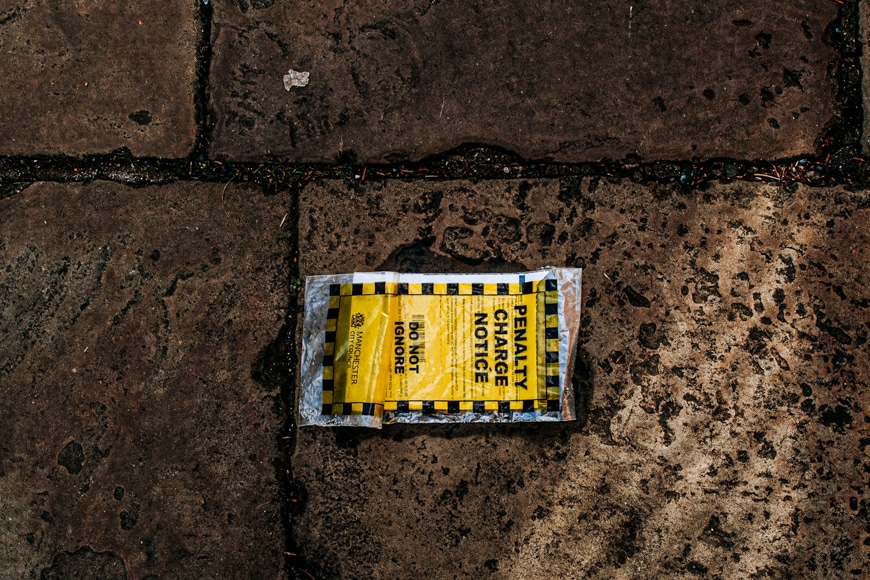
Credit: Patrick Mateer
This has continued through the years, and for contemporary street photography inspiration, we highly recommend looking at Alex Webb, Matt Stuart, Lee Jeffries, Shinya Arimoto, Angelo Ferrillo and Eric Kim.
The influence of street photography has been embedded within popular culture. You can see its imprint in other types of photography – ‘layering techniques’ often used in street photography can be seen in modern documentary wedding photography.
‘Urban environment photography’ is a sub-genre of ‘urban photography’ and usually shows scenes without people. It follows the tradition of landscape photography capturing the essential feeling of a place – and is sometimes referred to as ‘urban landscape photography’.
Typically, and unlike street photography, urban environment photographers don’t include, or at least, don’t focus on people. The every day and the run down are as popular subjects as are big city buildings and thoroughfares.
And of course, urban environment photography includes the large park areas that many cities have as cultural and environmental centres.
‘Urban decay photography’ is about the old, the abandoned, the unused and the unloved buildings – the vacant lots in cities. For instance, old factories, boarded-up housing and unused filling stations provide a rich source of visual interest.
They often have an eerie, dystopian atmosphere for the photographer to explore. There is a serious side to this as a photographic record of the old industrial past before it falls to the wrecking ball and new developments.
For instance, the photographing of old cinemas is popular with many social history photographers. Travelling to former Eastern Bloc countries in Europe to photograph the huge housing developments constructed after WW2 has become a popular tourist photographer trail.
14 Urban Photography Tips
Whether you decide on a subject before you go out to take photos or decide to roam free and see what catches your eye, some general urban photography tips are to become as visually aware as possible. Try to train yourself to see the full scene, but also to pick out the most visually interesting aspects to hone in on.
How Much Do You REALLY Know About Photography?! 🤔
Test your photography knowledge with this quick quiz!
See how much you really know about photography...

With this main piece of advice in mind, here are 14 further tips to help you on your way as you get to grips with urban photography.
1. Carry your camera with you and be ready to react

Credit: Mike Lorusso
It’s sometimes hard to tell exactly when the perfect opportunity for urban photography will present itself. It’s great if you can make time to spend whole days at one location, waiting for the ‘decisive moment‘.
But modern life doesn’t always afford that luxury. So why not try taking your camera with you, wherever you go, for a few weeks.
Then when that poignant or amusing moment occurs, you’ll be ready to capture it.
2. Use black and white for atmospheric urban photography
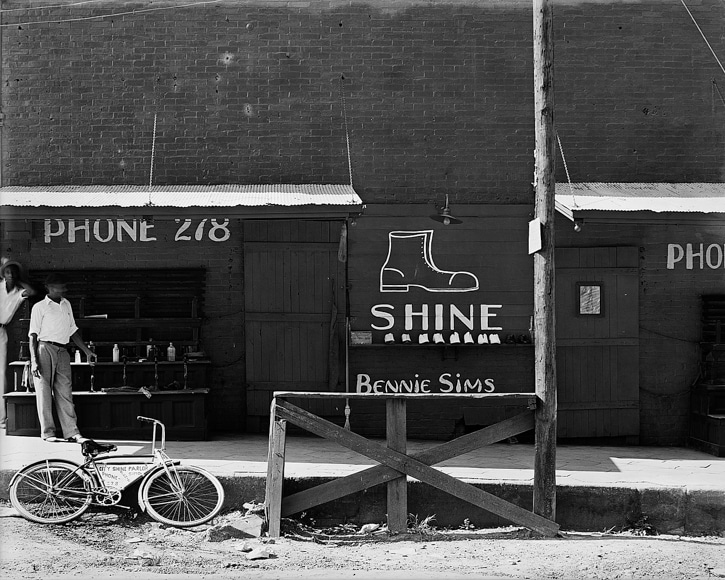
Credit: Walker Evans
Using post-processing to render urban photography in black and white can make for telling images, dramatic contrasts, or reflective grey tones.
You can try out some test shots in color and black and white in your camera to see which mode suits the subject and the light – then, switch to shoot in RAW when taking your final image, and convert to black and white while editing. This will give you the best results overall.
The example image above is by the great Walker Evans and was shot in the 1930s on film.
3. Try incorporating reflections in your urban photography
Reflections are a great starting point if you want to try something a little different. It gives you something to look for that will help you see the city anew and in photographic terms.
The city is full of reflections, either directly from or through windows. Then there are reflections in shiny car bonnets, in sunglasses and rear-view mirrors, in chrome door handles and on water at fountains or dank side street puddles. And what is being reflected – people, clouds, other buildings?
Having found your reflections, how best to frame the image? How best to expose the image? How best to focus? Try things out. Criticise your results. Move on to new challenges.
Adding reflections to your urban photography can really make it stand out from the crowd (apologies for the street photography pun!)
4. Use depth of field to tell the story
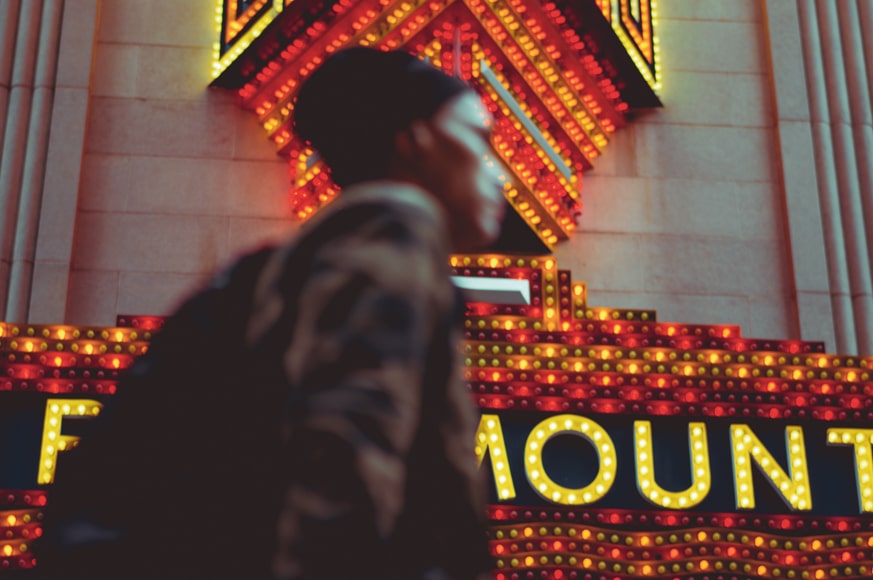
Credit: Ellis Garvey
Urban Photography is generally about people in the city environment – so get your camera and lenses ready. Then, you need to consider what story you want to tell.
Depth of field is a crucial aspect of photographs where there are groups, as on a pavement. A wide aperture (f/1.4 to 2.8) isolates a figure or a couple in the general throng. A narrow aperture (f/16 for example) puts everyone into near equal focus around your focal point.
Narrow aperture is part of the classic urban photography aesthetic. Move your camera position and you can ‘layer’ the subjects in your images from the people in the foreground, through the middle ground, to the shop signs in the background and the building silhouettes in the far background.
5. Look for natural vs man-made elements to photograph

Credit: Lewis Parsons
Cities abound with situations where the natural world is seen against man-made constructions. For example, a line of trees along a street throws organically shaped shadows over the geometric shapes of the buildings.
A flock of pigeons within the morning rush hour and the resultant pollution. There is a world of contrasting imagery for you to capture in the urban envirnoment.
6. Try long exposures of moving people and vehicles
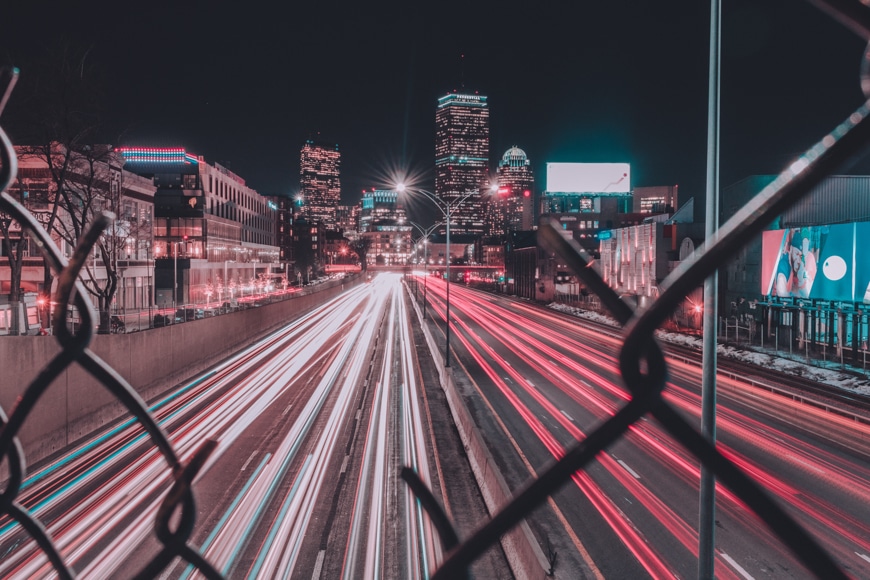
Credit: Alex Iby
How do you capture the movement of the city? The cars speeding past, a jogger, people hurrying over a crossing.
Standard exposures will ‘freeze’ the movement into a static ballet. However, you may want to capture something a little more photo-tangible in terms of movement.
To do this, set the camera to a long exposure – for example, 1/10 shutter speed – while keeping the aperture narrow. Remember, light is ‘exposing’ onto the sensor throughout the exposure time. So you need to compensate for this in terms of narrow aperture and or low ISO; otherwise, the whole image may over-expose.
Long exposures need some experimentation – but with digital cameras, that’s not so difficult. Keep viewing your images and see what appears to be the best settings, and try again.
Smooth and steady looking long exposures used to only be achievable with a tripod – however, nowadays, many cameras and lenses have image stabilisation built-in, meaning you can handhold long exposures effectively.
Nikon, Sony and Canon mirrorless cameras, in particular, have excellent image stabilisation built into their camera bodies.
7. Subject contrasts add a layer of interest

Credit: Ed Robertson
One of the stock tropes of Street and Urban Photography is contrasts. An ostentatiously dressed person in the same frame as another who is in joggers with mussed up hair.
A sign in the background whose message takes on a new meaning when coupled with people walking past or standing nearby can be ironic, funny or even poignant. And as with people, the same applies to buildings; there is the small against the large, the dilapidated against the sparkling new.
So, look for these contrasts – the dry-cleaning shop behind a person walking past in the rain, soaked to the skin.
These kinds of images also open up the opportunity for social commentary, which can add another dimension to your work; or, you can just play with it just for laughs.
8. Change the viewpoint to create new images

Credit: David Vives
Walking around with your camera will mean most of your work will be at eye level. This is good for many situations: you/the camera meets the subject on a level and democratic playing field – you are not imposing yourself.
However, moving your camera position up or down slightly can make quite new compositions and relationships of the elements within the image.
Rooftops, high windows, stairwells in big shops, walkways and bridges, or simply lifting your camera up above your head or placing it at street level can open up a new visual landscape for your city photography to operate within.
Of course, a note on health and safety – take care and assess the risk before you go climbing on anything, and remember the camera can upset your natural balance!
Never attempt anything risky or dangerous – that goes for Urban Decay Photography too, don’t enter a building unless allowed to do so and don’t enter any building that may be dangerous.
9. Repetition of color can create a visual conversation
In Landscape Photography, there’s an obvious layering of colors – blue sky, purplish hills, green forests and fields of yellow and browns in the foreground – for you to work with.
In the city with its acres of grey concrete, brown brick and asphalt roads, color is something that has to be looked for. But, once found, you can really make the most of it.
And how do you get that splash of green or blue to the intensity that matches your observation of it? Look for repetition in photography – look for visual conversations.
So if there’s a red bus, look for someone passing wearing red – repetition can add humour and depth to your work. When you start to really consider color and expressions on faces and space and movement, your work really will be elevated.
10. Try abstraction of the urban environment
Using close up wide-angle or telephoto shots of buildings can reveal an abstract world of patterns (2-D) and forms (3-D). Look for corners, where two structures meet, the lines of construction.
Positioning your camera to achieve perfect horizontals and verticals or to show up strong diagonals often plays an important part.
How much of a building can you zoom in on until you lose the feeling of it as a structure? Use a telephoto lens to achieve this and create abstract urban photography.
11. Know how to shoot in different weather and light

Credit: Elton Yung
One of the most basic urban photography tips is that your subject and the geographic location may determine what time of day you go photographing.
You may choose the ‘golden hour’ – the hour before sunrise and after sunrise – when cool concrete will take on a warm tint and you can capture a full spectrum of tones.
But don’t be shy: rain or shine, windy or calm, snow or ice; night or day, evening or morning, the city is always alive. And alive to changing conditions and light.
Umbrellas are great fun for an urban photographer – pattern, color invites. People’s actions and body movements also alter with the weather.
Whatever the weather, light changes quickly, so take lots of photographs, capture the passing of the day. As Garry Winogrand said, “I photograph to find out what something will look like photographed.”
You will then start to learn what time of day you like to shoot in or what weather attracts your mood or even becomes a signature in your work. More importantly, you may find that you can photograph in all types of light and weather – and use each variable to say something different.
12. Try shooting with a film camera for authentic urban photography
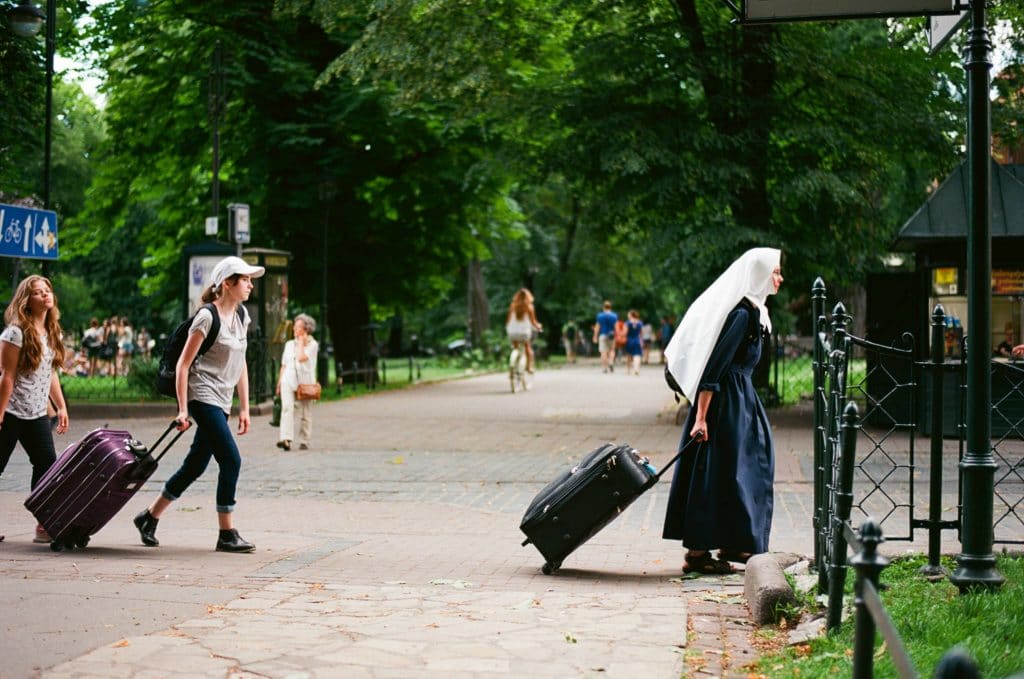
Credit: Image by Patrick Mateer (shot on a Nikon SLR film camera)
Street and Urban photography was pioneered with 35mm film cameras – so why not try shooting with a couple of rolls of film during your next urban photography expedition.
Not only will this give an authentic feel to your work, but having a limited amount of shots per roll of film will also encourage you to slow down.
You will find yourself naturally begin to consider your subject, consider your light – you’ll really have to look for the colors you want to capture and other visual relationships that will make your work stand out.
Shooting on digital cameras is great – but shooting on an old film camera can really help you develop your skills in terms of photography and artistic visualisation. You can pick up an old Olympus point and shoot fairly cheaply or an old SLR on eBay.
Look online and you soon find there’s a vibrant analogue photo-community out there, and processing can be done by post… or you can try your hand at developing film at home.
13. Shoot with a fast shutter to freeze life
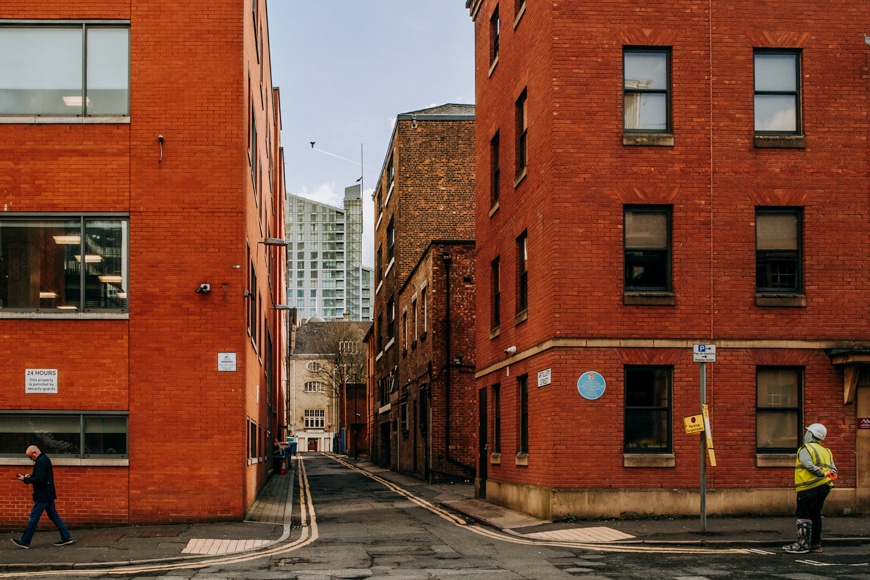
Credit: Patrick Mateer
We’ve discussed how slow shutter speeds can add something special to your work in terms of showing movement – however, you may want to keep your shutter speed high to capture the busy streets and urban landscapes you’re working within.
Set your shutter to 1/1000 – along with a narrow aperture – and you really can ‘flatten’ the scene and capture really fleeting moments. Be ready to compensate with high ISO though!
14. City photography means considering ethics
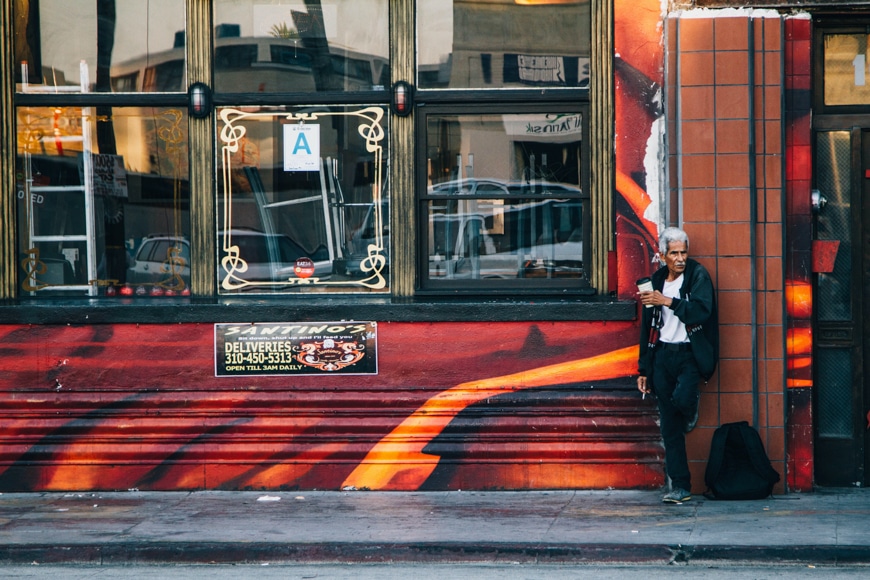
Credit: Nathan Dumlao
If you only take one of these urban photography tips with you, make sure it’s this: Any rights you may have as a photographer to take photographs are balanced by other people’s right to privacy and consideration – and that includes in public places.
In many countries such as the USA and UK, you are generally able to take photographs in public spaces. However, that is not the case everywhere in the world – you should check the rules of the country or region you are in.
And while these days it seems everyone is taking images with mobile phones, if you are equipped with a larger camera or look to be photographing in a ‘non-tourist’ way, you should be aware of possible implications.
If you are taking photographs of people you don’t know, look for the clues in their body language and if they don’t look comfortable or indicate ‘No’, then back off with a nod and a smile.
You can, of course, ask someone – it’s best to try some general conversation and an introduction, before you say, ‘Can I photograph you?’
Of course, with urban photography, there is the overarching principle that all images should be taken with a documentary approach – this means no posing, no staging. So street and urban photographers certainly don’t approach their subjects to ask for permission first.
However, the average urban photographer tends to choose to shoot with wide focal lengths – 20mm, 24mm, 28mm or 35mm, for example. They then get close to their subjects – so they cannot ‘hide’ that they are photographing someone.
So, there is the opportunity for the subjects to object – again, if this happens, you should respect this.
Before he became ‘famous’, the great Joel Meyorwitz spent the 1960s roaming the streets of New York with a 35mm film camera. If you look at Meyorwitz’s work from this time, you will see some people rushing by or simply going about their everyday lives. But occasionally, some stop and stare down the camera lens. We, of course, don’t see the time’s someone waved him away.
You will find this as true today as it was then – some people will not look twice at the camera. Others will ask to be out of the frame or will actively ask you to not photograph them – where others will relish the chance of a fleeting moment in your spotlight.
Though you may be tempted to photograph people in the street from afar with a telephoto lens and your silent shutter mode on, please consider when observation may become voyeurism.
Children and the differently-abled are particular categories to be aware of, and you shouldn’t take photographs of them without parental or carer permission.
Urban photography in countries foreign to you deserves particular attention. You are a visitor and will be photographing other cultures where social expectations and norms may be quite different to your own.
Try and find out what you can and can’t do as a photographer, especially if you move out of tourist areas. Are you photographing your subject with respect?
Asking and receiving permission to take portraits has become another sub-genre, ‘Street Portraits’.
As you can see, it’s a varied and incredibly nuanced subject – in some senses, if your subject is ‘the street’ rather than ‘an individual’ this means you are documenting a wider subject. Step back, and you can make your images about the street and the life within it – it doesn’t have to be about recognisable faces.
But if you do get close to people through your lens, never lose sight of the importance of respect, kindness and consideration when photographing others. This is an important part of your practice as an urban photographer.
Final Words
We hope our guide has given you the confidence to start experimenting with Urban Photography. It’s such a varied and enjoyable type of photography to immerse yourself within.
Choose your locality and sort out your equipment and then: take time to explore; have the patience to see the interesting around you; take photographs to see what comes out; study and be critical of your own work, and look at other people’s work alongside the world around you for inspiration.
The photographer Elliott Erwitt once said, “To me, photography is an art of observation. It’s about finding something interesting in an ordinary place…I’ve found it has little to do with the things you see and everything to do with the way you see them.”
Please get in touch via the comments if you have any questions at all, and we’d be happy to help you.

Check out these 8 essential tools to help you succeed as a professional photographer.
Includes limited-time discounts.





